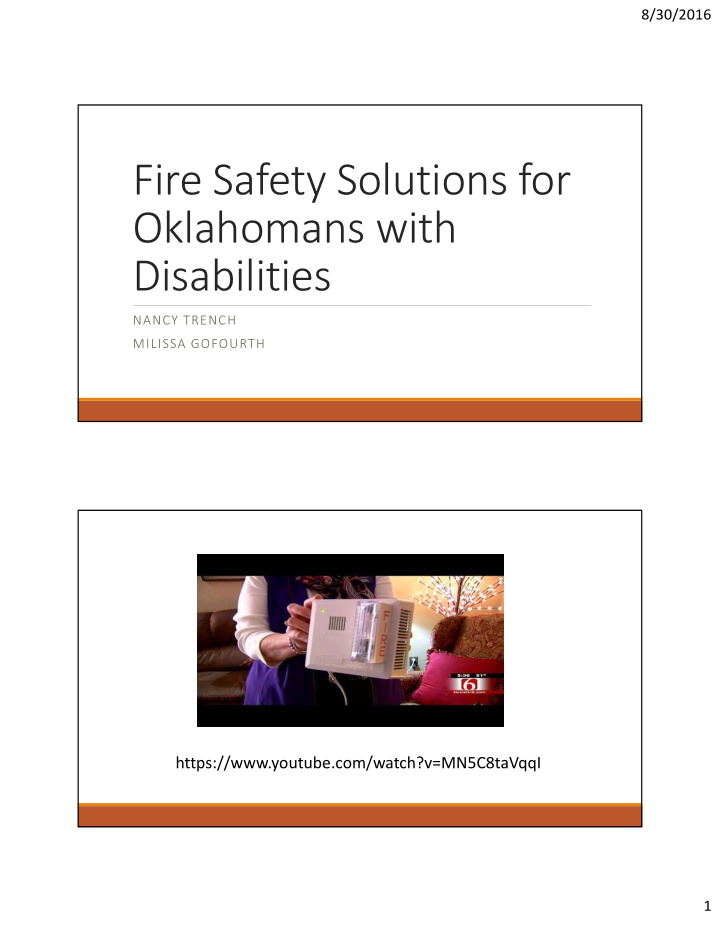



8/30/2016 Fire Safety Solutions for Oklahomans with Disabilities NANCY TRENCH MILISSA GOFOURTH https://www.youtube.com/watch?v=MN5C8taVqqI 1
8/30/2016 Facts • More people die in home fires than in tornadoes in Oklahoma • More people die in home fires across the United States than in all other disasters combined • Physical disabilities are a factor in 14% of fire deaths in U.S. • Death rate is 15 per million population for people with disabilities • Death rate is 9 per million population The Oklahoma Program • FEMA Funded (Assistance to Firefighter Grants) • Statewide • No income requirement • No cost to the consumer • $400 worth of equipment per household • Pay trained installers • Program does not install in licensed facilities • Program Contact Information should the equipment malfunction 2
8/30/2016 Serving People with Disabilities with Smoke Alarm Installations • Engage people with disabilities – what do you want to know about home fires and HOW? • It takes time to develop a true partnership in trustworthiness • Once ASL Interpreters began to recommend the program • All materials in alternate formats, Braille, Audio, Large Print, ASL DVD, HTML, etc. • If requested always provided paid ASL interpreters Partnerships • Home Fire Safety Technical Partner(s) • Always inform the local fire department, the level of engagement varies community to community • State Fire Marshall • State Fire Training Services • Disability Advocates/Organization • Assistive Technology Act program in your state • Rehabilitation agency • Center for Independent Living • Community ‐ based organizations 3
8/30/2016 Building a Partnership for Success • Research Funding Sources – know the requirements • Federal and State Agency • Local Programs • Foundations and Insurance Providers • Red Cross • Create a Compelling Story – Why do People with Disabilities need appropriate equipment • Plan the Doable Involve People with Disabilities • Nothing about Us Without Us – the Disability Partner formed Focus Groups • Deaf/Hearing Loss • Blind/Low Vision • Mobility • Cognitive • Lessons Learned • Modify common home fire safety messages ‐ not all messages work for all • Created a DVD in ASL 4
8/30/2016 Marketing • News Release • Television/Radio Interview • Websites • Social Media • Events • Silent Dinners • Health Fairs • Conference Presentations/Booths • Satisfied Consumers Program Components • Traditional canvassing door ‐ to ‐ door smoke alarm installation does not work to serve people with disabilities • Application based program • It provides programmatic information as to who is served • Eligibility determines proof of disability • Arrange for home installation appointment • Formal Agreements with paid trained installers 5
8/30/2016 Trained Installers • Serving people with disabilities (4 hours) • Social Etiquette • People First Language • Working with ASL Interpreters & service animals • Smoke Alarm & Alert Equipment Installation (3 hours) • The right alarm in the right place makes a difference • Bedside alert device set ‐ up and sync • Home Safety Messages Program Evaluation • Critical to collect both qualitative and quantitative data • Change in behavior • Satisfaction level • Respond to feedback – especially if an alarm malfunctions • Regular Partner meetings • Evaluate timeliness and effectiveness • Outreach • Installations • Changes and improvements 6
8/30/2016 Quality Assurance • Install Alarms – Giving Away is NOT effective • One is Not Enough – NFPA Standards • Install 2 Types of Alarms • Photoelectric – smoldering or dense smoke fires • Ionization – fast flaming fires • Prevent Nuisance Alarms – location, location, location • Replace Old Alarms ‐ Smoke alarms are only functional for 10 years Fire Deaths Occur at Night • Smoke alarms save lives because they alert people to a fire • Smoke alarms are on duty detecting smoke 24/7 • Deadly home fires occur while people are sleeping, so the primary emphasis is: Smoke alarms need to intercept smoke from a fire before the smoke reaches sleeping people • The smoke alarm must wake people. The standard smoke alarm sound does not wake some people. They need to be alerted with a low frequency sound and a bed shaker (tactile alert) 7
8/30/2016 Install Bedside Alert Devices • People who are deaf and people who are hard of hearing need an alert device to awake them • Alert devices are NOT smoke alarms, they listen for the smoke alarm alert sound to activate • The alert device makes a low frequency sound and a shakes the bed • Check for the UL or ETL listing Lifetone & SafeAwake 8
8/30/2016 Smoke Alarm for People Who are Deaf In the Home • Installers need to take the time to train the resident(s) on how to operate and test the alarm and alert device • Discuss and plan to practice the family fire escape • Provide additional Fire Safety information – How to Prevent a Home Fire 9
8/30/2016 Replicate the Oklahoma Program • Application • Home Fire Safety Materials • 2 Training Program Curriculums • Follow ‐ up Survey • 2 DVDs • Home Fire Safety for YOU – Presented in American Sign Language • Meet Natalea – Retrofit Home Fire Sprinkler System https://www.ok.gov/abletech/Fire_Safety/index.html Contact Nancy Trench ntrench@osufpp.org Milissa Gofourth milissa.gofourth@okstate.edu 10
Recommend
More recommend